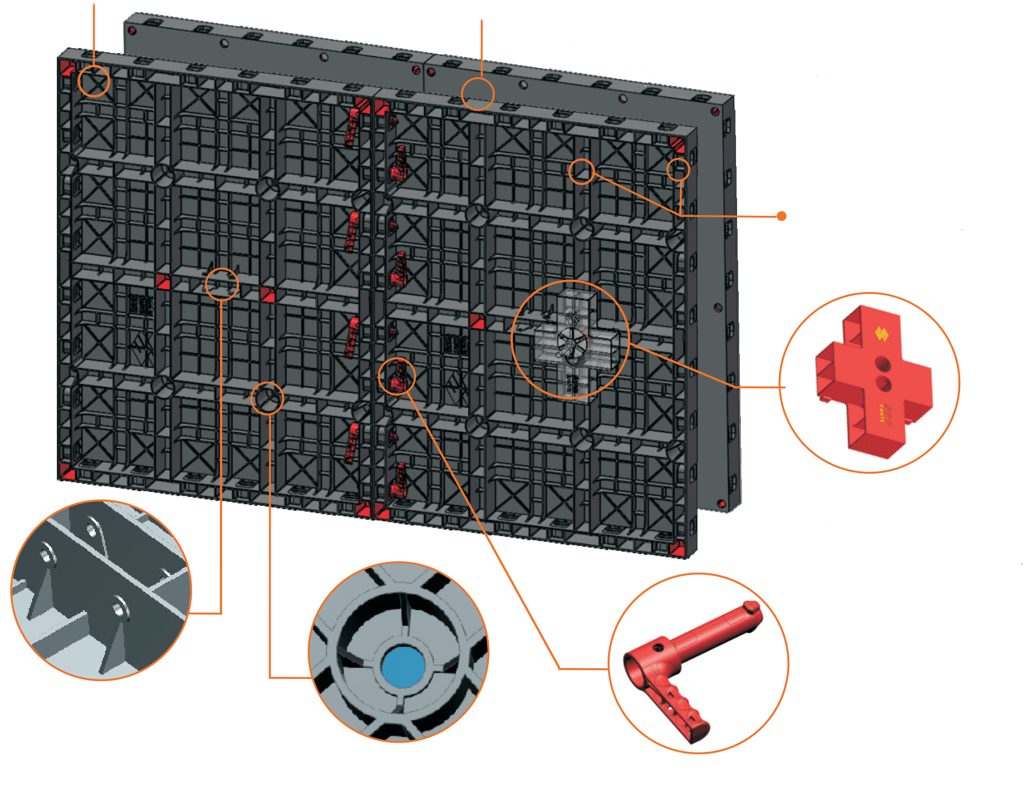Get cost-effective formwork solutions today!
2 Tips for Better Use of Plastic Formwork
Better Use of Plastic Formwork
zhuniu
7/4/20255 min read


Understanding Plastic Formwork
Plastic formwork is an innovative construction material designed to create temporary support structures for concrete during the curing process. Unlike traditional materials such as wood or metal, plastic formwork is composed of high-density polyethylene or polypropylene, which makes it lightweight, durable, and resistant to moisture. This unique composition contributes to its growing popularity within the construction industry, as professionals continuously seek more efficient and sustainable building solutions.
One of the primary advantages of plastic formwork is its ease of handling. Due to its lightweight nature, workers can quickly transport and manipulate the components, ensuring a more streamlined construction process. Additionally, plastic formwork can be reused multiple times, reducing waste and lowering material costs over the project’s lifespan. Compared to traditional materials, plastic formwork provides a safer working environment by minimizing the risk of injury associated with heavier products.
Plastic formwork is often preferred for projects requiring precise concrete finishes. Its smooth surfaces contribute to better-quality surfaces and reduce the need for extensive finishing work after the concrete has been poured. The system accommodates various architectural designs, making it suitable for both residential and commercial projects. Furthermore, the adaptability of plastic formwork enables it to be formed into different shapes, which can encourage more creativity in architectural design.
In terms of sustainability, plastic formwork aligns with growing environmental concerns. Its longevity, combined with the potential for recycling and reduced waste generation, positions it as a more eco-friendly alternative to traditional materials. As construction practices evolve, the adoption of plastic formwork continues to rise, reflecting the industry's commitment to implementing modern solutions that meet both performance and sustainability standards.
Tip 1: Choose the Right Type of Plastic Formwork
When selecting a plastic formwork system for construction projects, it is essential to consider various types available in the market. Plastic formwork systems are designed to cater to diverse needs, ranging from lightweight solutions for small-scale structures to heavier applications suitable for large buildings. The right choice will depend significantly on the specific requirements of the structure, project budget, and environmental conditions.
One of the main types of plastic formwork is the modular system, which allows for easy assembly and reusability. This system can be customized for different shapes and sizes, making it ideal for projects requiring flexibility. For instance, if your project calls for a significantly curved wall, a modular plastic formwork can adapt more readily than traditional forms. Another popular option is the insulated plastic formwork, which provides thermal insulation properties, contributing to energy efficiency in the completed structure. These systems are particularly advantageous in colder climates where maintaining internal temperatures is critical.
Environmental conditions also play a role in formwork selection. If working in an area prone to damp conditions, consider plastic formwork that resists moisture and potential mold growth. Likewise, if the project faces extreme temperatures, certain plastic materials can perform better than others, ensuring durability throughout the construction phase. Lastly, the project budget is a critical factor. While high-end plastic formwork may offer enhanced performance and longevity, it may not always be the best choice if it exceeds budget constraints. Comparisons between various types in terms of cost, reusability, and lifecycle can aid in identifying the most cost-effective option.
In summary, choosing the right plastic formwork involves assessing the structural requirements, understanding environmental conditions, and aligning the decision with the budget available. A careful evaluation of these factors will lead to informed choices that ultimately improve project efficiency and outcomes.
Tip 2: Proper Installation Techniques
When utilizing plastic formwork for construction projects, proper installation techniques are critical to ensuring the integrity and stability of the structure. In order to achieve optimal results, it is essential to follow a systematic approach during the setup of plastic formwork panels. The first step involves preparing the site by ensuring the ground is adequately leveled and free of debris. This foundational work is crucial, as an uneven surface can compromise the alignment and stability of the formwork, leading to potential structural issues.
Once the site is ready, begin the installation by carefully positioning the plastic formwork panels according to the project specifications. It is advisable to consult the manufacturer’s guidelines, which provide valuable insights on the best practices and techniques for installation. Align the panels accurately, ensuring that they fit snugly together without any gaps. Using spacers can assist in maintaining uniform spacing between the panels. During this process, it is vital to constantly check for level using a spirit level or laser level to guarantee the panels are set correctly.
Securing the panels is the next crucial step in the installation process. Depending on the design and requirements of the project, the panels may need to be anchored using brackets, pins, or weights. Ensure each panel is firmly secured, as any movement during concrete pouring can lead to significant problems, including leaks and deformities in the cured structure. Additionally, reinforce the areas where the panels meet and where load-bearing is anticipated to avoid any deformation during the concrete setting.
Lastly, adhering to safety precautions is paramount. It is important to wear appropriate personal protective equipment and follow all safety protocols while handling and installing the formwork. By diligently applying these proper installation techniques, the longevity and functionality of the plastic formwork will be significantly enhanced, ultimately contributing to the success of the construction project.
Maintenance and Care of Plastic Formwork
The longevity and efficiency of plastic formwork significantly depend on comprehensive maintenance and care. Implementing a systematic approach to cleaning, storing, and inspecting the formwork can extend its lifespan and ensure optimal performance on construction sites. To begin with, it is essential to adhere to specific cleaning protocols. After each use, plastic formwork should be cleaned thoroughly using a mild detergent and water. This regular cleaning helps to remove concrete residues and other contaminants that can hinder the performance of the formwork in subsequent projects. It is advisable to avoid abrasive cleaners that may scratch or damage the surface of the formwork.
Proper storage of plastic formwork is equally crucial. Formwork should be stored in a dry, cool location away from direct sunlight and extreme temperatures. Prolonged exposure to the elements can degrade the material, leading to a decrease in structural integrity. When stacking formwork, it is important to do so in a manner that prevents warping or bending. Placing a protective layer or using a pallet for support can further help maintain the formwork's shape during storage.
Routine inspections are necessary to identify any signs of wear or damage. Inspect the formwork for cracks, breaks, or any deformation before each use. Minor damages, such as small cracks, can often be repaired using specialized plastic adhesives designed for construction materials. However, if the damage is extensive or compromises the structural integrity of the formwork, replacement should be prioritized. Investing in high-quality plastic formwork and following these maintenance tips can significantly reduce replacement frequency, thus offering cost-effective solutions for construction projects over time.
Get in touch
Share with visitors how they can contact you and encourage them to ask any questions they may have.


